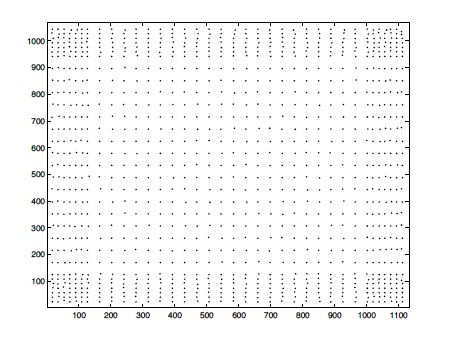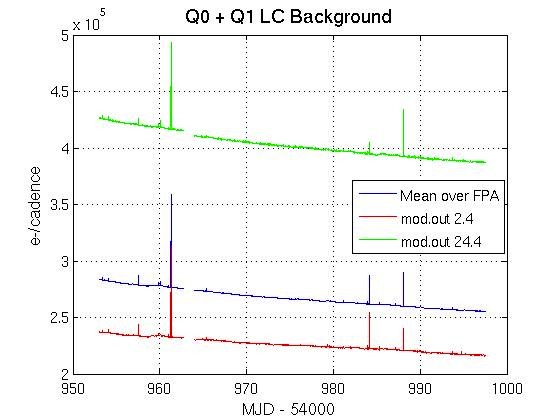|
|
|
||

| |||
| Kepler Calibration | |||
|
BACKGROUNDS
OVERVIEW To derive calibrated photometry, robust background subtraction is a necessary and familiar step. Source photometry is affected by a number of backgrounds contributors, both celestial and instrumental backgrounds. During nominal science data collection, pixels designated as background are measured in addition to target pixels. These data are used to correct the photometry within the Photometric Analysis pipeline module. In addtion to correction of source photometry, measures of the spatial and temporal background flux are by themselves an important science topic, with a long and rich pedigree (e.g., the CMBR). Backgrounds at many wavelengths are the sum of a number of processes; peeling back each layer has provided valuable insight onto cosmic evolution [ultraviolet: Bowyer, AnnRev 29, 59 (1991); Henry, AnnRev 29, 89 (1991); infrared: Hauser & Dwek, AnnRev 39, 249 (2001); soft x-rays: McCammon & Sanders, AnnRev 657, (1990)]. Kepler provides a continuous measure of the celestial background in a wide optical/near-IR band over a 100 square degree FOV for 3.5 years nominal mission length. Due to Kepler's unusual operational strategy,
the method
applied for background removal differs from the most common approach
used in astronomical applications. Backgrounds are usually estimated
from a annulus of pixels immediately adjacent to the source, scaled
to a common area. Kepler does not use this approach, rather a separate
set of background apertures are collected across the focal plane, and
a background measure derived from these pixels. GOs should note that
the pipeline does not use pixels within the source aperture to
measure the local background.
COMPONENTS Celestial backgrounds arise from a number of sources, both from spatially smooth, diffuse light which affects all pixels in the aperture, and from transient events, which affect a few pixels.
Instrumental backgrounds
include the detector bias level (also termed black level),
which is removed in the CAL
pipeline module, some anticipated issues, such as scattered
light, unexpected electronic issues discovered during pre-flight
characterization of the detectors, and some features seen during
early flight operations, e.g.,v"argabrightening",
an anomalous full-field illumination, whose origin is under
investigation by the instrument team
(Jenkins etal 2010). Spatially varying backgrounds
produced by the detector electronis are full described in the
Kepler Instrument Handbook
(KIH). The Kepler project is investing considerable effort to
identify, assess, and develop corrections for instrumental signatures
discovered during the early phase of data collection. Additional
details on the spatially-varying image artifacts, and
their corrections can be found on the GO
Data Artifacts page.
MEASUREMENT & REMOVAL Kepler constructs a background flux map using a set of target pixels specifically assigned for this purpose. Background "targets" are small (nominally 2 x 2 pixels) postage stamp images which measure the background signal in the long cadence observations. Since backgrounds must be estimated and removed from all observed sources in the FOV, a method was adopted to interpolate background values from all targets pixels in a channel using the background apertures in that channel. A maximum of 1125 background apertures and 4,500 pixels (~4 pixels per target) are allocated for each of the 84 output channels. These background targets are selected to optimize a 2D polynomial representation of the background flux distribution, derived separately for each channel. For robust fitting, background apertures should be uniformly distributed on each CCD array. To mitigate edge effects, more background apertures are positioned at the frame edges. During target management prior to each quarter, background pixels are selected, avoiding stars and locations affected by charge bleeds. |

| Distribution of background apertures in a typical Kepler CCD frame. Spacing of background pixels is increased along the frame edge to improve the fit to the background. |
| Background pixels are calibrated in the same manner as source pixels in the CAL pipeline module. Background channel maps are generated in PA; interpolated background values are then subtracted from the pixel values prior to aperture photometry. |
|
A measure of the celestial background in the Kepler FOV is provided by VanCleve in Data Release Notes 5. The figure below shows the background flux time series for the Q0+Q1 observing season, derived from the reprocessed data released on 15-June-2010. Time series are shown for the full focal plane, and for channels closest to and furthest from the Galactic plane. From this plot, a few items are evident:
|

Background time series for observing quarters Q0 + Q1. The curves show average over all mod.outs (CCD channels), the modules furthest from (mod.out 2.4 = channel 4) and nearest to (mod.out 24.4 = channel 84) the Galactic plane. The vertical offset is produced by the spatially-dependent Galactic emission; the horizontal trend is caused by variation in the zodical light. The narrow spikes visible in all 3 curves are Argabrightening events. Observations affected by these diffuse brightenings are tabulated in the release notes. |
|
GUEST OBSERVER ISSUES What should GOs be concerned about regarding backgrounds ?? Background subtraction is normally a user-driver reduction step, not a pipeline function. The current assessment is that the pipeline background corrections do not produce significant noise or errors in the extracted light curves. A few steps which GOs can take to examine their specific situations:
|
![]()
Questions concerning Kepler's science opportunities and open programs, public archive or community tools? Contact us via the email address.